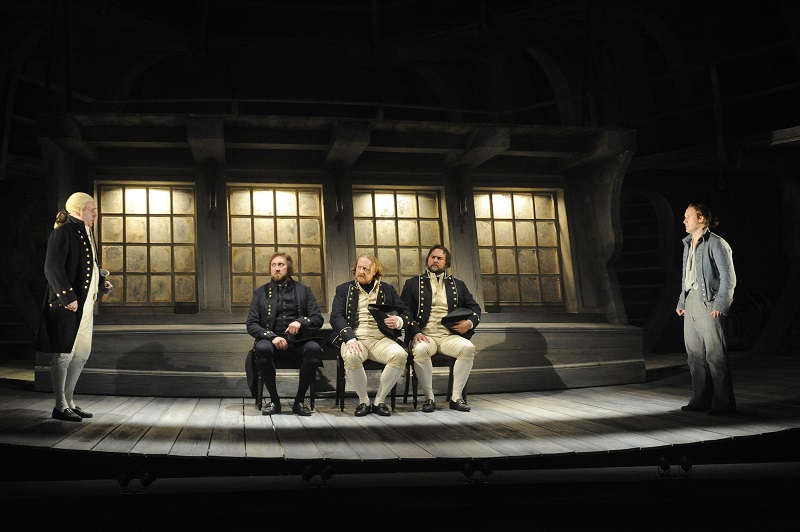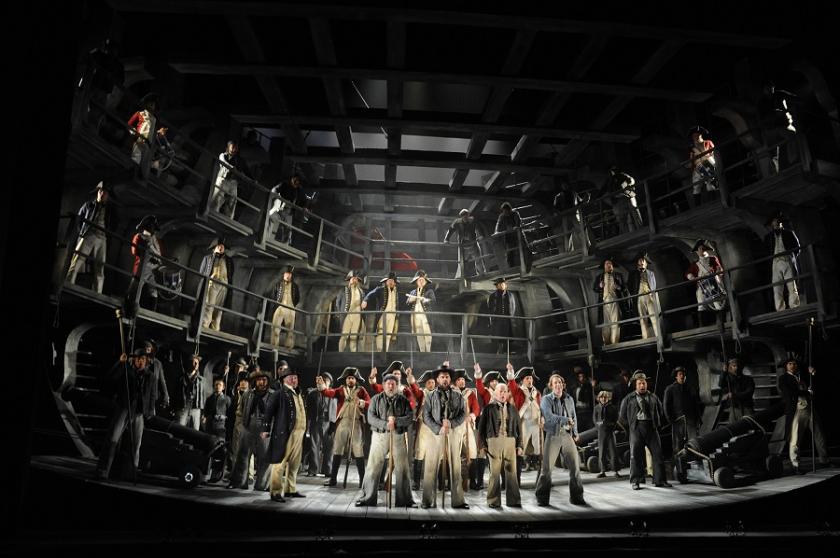“O what have I done, o what, what have I done? Confusion, so much is confusion.” So sings Captain Vere in the Prologue of Billy Budd and Benjamin Britten plunges us straight into this confusion from the very first bar as we are left in uncertainty which of two keys - B flat major and B minor - will prevail. Their simultaneous sounding is an apt metaphor for the moral ambiguity which pervades the opera and which is given a dramatic, meteorological presence when the mist descends on the ship in Act 2.
I have known and loved Billy Budd ever since seeing it at ENO in 1988 in the Tim Albery staging with Thomas Allen, Philip Langridge and Richard Van Allen. I was thrilled by the power of the music and the strangeness of the story. I particularly remember the wonderful excitement of hearing the big chorus moments - the Act 1 scene where the entire crew assemble below decks and swell on a single note with a seemingly endless crescendo, the battle scene at the start of Act 2 and the attempted mutiny at the end of the opera. I was then fortunate enough in 1999 to be asked to sing the Novice in concert performances and a subsequent recording of the opera conducted by Richard Hickox with Simon Keenlyside, Philip Langridge and John Tomlinson as the unsurpassable protagonists.
This sort of criticism was hard for Britten to take but it seems to have spurred him on
These encounters, as exciting as they were, had not prepared me for the extraordinary pleasure of working on the revival of the Michael Grandage production that is just about to open at Glyndebourne. One of the delights of working at Glyndebourne is that revivals are given the same care and attention as original productions - it is a sort of “slow-food” approach as opposed to microwaving a pre-prepared dish. Fresh ingredients are assembled and allowed to develop their own flavours over a six-week rehearsal period. This has enabled me to “study and ponder”, as Vere says in the prologue, the world conjured up by the creative geniuses of Herman Melville, EM Forster (with some help from Eric Crozier) and Benjamin Britten.
Melville's last work, left unpublished at his death, was written by a despairing old man who felt that recognition had passed him by. Moby Dick had long since faded from view and he was remembered, if at all, for his travel and adventure stories. Billy Budd, Sailor was not rediscovered and published until 1924. By then, too late for Melville to know, he was being hailed as one of America's greatest writers. Forster was quick to acknowledge the importance of Billy Budd and gave it a prominent place in Aspects of the Novel (1927). It is not hard to see what attracted Forster: “I want to love a strong young man of the lower classes and be loved by him and even hurt by him,” he wrote in a personal memorandum in 1935. Billy, Claggart and Vere almost seem like characters in a Forster novel and inhabit a world beset by “muddle” (one of Forster's favourite words), confusion and mist.
The collaboration between Forster and Britten on the 1951 opera was one of the most challenging of the composer’s career. Forster was nearly 70 when he started work on the libretto, Britten just 36 and somewhat in awe of the famous author. Forster, however, was inexperienced in theatre, hence the engagement of Crozier as co-librettist, and not particularly musical. One of the great fascinations of the finished opera is the way that Forster makes Melville's story his own and then Britten does the same to Forster's libretto. (Pictured below, Mark Padmore © Marco Borgrevve)
 A good example of the creative tensions between the two men came after Britten had played through Act 1 to Forster at the Red House, the composer's Aldeburgh home. Forster wrote to Britten about Claggart's aria shortly afterwards: “It is my most important piece of writing and I did not, at my first hearing, feel it sufficiently important musically… I want passion - love constricted, perverted, poisoned, but never the less flowing down its agonised channel. Not soggy depression or growling remorse.”
A good example of the creative tensions between the two men came after Britten had played through Act 1 to Forster at the Red House, the composer's Aldeburgh home. Forster wrote to Britten about Claggart's aria shortly afterwards: “It is my most important piece of writing and I did not, at my first hearing, feel it sufficiently important musically… I want passion - love constricted, perverted, poisoned, but never the less flowing down its agonised channel. Not soggy depression or growling remorse.”
This sort of criticism was hard for Britten to take but it seems to have spurred him on to work with immense subtlety and imagination. Every line is inflected with a musical sense that informs us, often subconsciously, of its meaning. It is as if Britten had taken Forster's injunction “only connect” to hear, so that many of the musical themes are shared between different characters. hinting at their connectedness but also allowing us to experience the story with, to use Keats' phrase, “negative capability: that is, when a man is capable of being in uncertainties, mysteries, doubts, without any irritable reaching after fact and reason.” In other words, to relish the ambiguity.

Pictured: the original Glyndebourne cast of Billy Budd
To take just a few examples: the theme that we first hear at Vere's words - “O what have I done?” (a rising fifth followed by a rising and then falling semitone) - becomes associated with discontent. The sailors scrub the decks with holystones to it, then Billy sings it at his adieu to the ship, and it is heard again during the Act 2 mutiny.
Claggart's theme of falling fourths followed by a rising semitone (“Let him crawl”) is taken over by Captain Vere after Billy kills the Master at Arms and is heard in its inversion of rising 5ths in the trial. The “Starry Vere” theme encompassing a rising 6th is also sung by Captain Vere when he mentions Billy Budd in the Act 1 cabin scene. Both Claggart and Vere sing “O beauty, handsomeness, goodness” about Billy to identical music.
Britten reserved his greatest coup for the scene that even Melville had shied away from describing - the interview in which Vere has to explain to Billy that he is to be executed for his moment of inarticulate anger when he strikes and kills Claggart. The 34 chords - all the possible harmonisations of the notes of the F major triad - leave it to each member of the audience to make up their own minds about what might be taking place in the cabin. It is a truly extraordinary passage and demonstrates that music can speak to us at a level beyond the capability of words or even ideas. Something happens in the cabin that transforms both Captain Vere and Billy but no explanation could ever be as powerful and deeply imbued with subtle meaning as those chords.
In the end Claggart is dead, Billy is hanging from the yardarm and we are asked by the “old man” Vere to believe that he has been “saved” and “blessed” and the “love that passes understanding” has come to him. The struggle between B flat and B minor appears to be over, suggested by the emphatic iteration of B flat major at the climax of the epilogue. And yet…
Once again Britten's extraordinary subtlety undermines any certainty as the orchestra fades out to nothing and the last note we hear is Vere's unaccompanied D - the one note shared between the two chords. The ambiguity, the “muddle”, will never be done.















Add comment